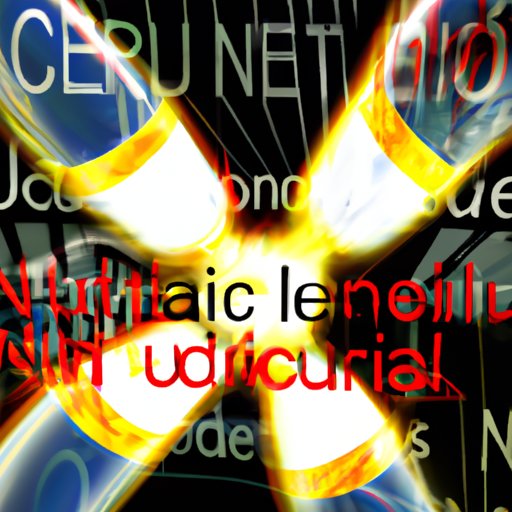
Introduction
When we hear the term “splitting an atom,” our thoughts may turn to nuclear bombs and devastation. However, the splitting of atoms also plays a vital role in nuclear energy. In this article, we will explore what happens when an atom is split and its impact on our world.
The Science Behind Nuclear Energy: What Happens When an Atom is Split
An atom is the basic unit of matter and consists of three types of particles: protons, neutrons, and electrons. The protons and neutrons are located in the center of the atom, called the nucleus, while the electrons orbit around the nucleus. When an atom is split, it undergoes a process called fission.
Fission occurs when a neutron collides with the nucleus of an atom, causing it to split into smaller nuclei and release energy in the form of heat and light.
Understanding Fission: The Consequences of Splitting an Atom
While the energy released from fission is a crucial component of nuclear power, it also comes with consequences. When an atom is split, it can produce radioactive materials that emit harmful radiation. These materials can take thousands of years to decay, making their proper disposal critical.
The danger of nuclear radiation is well-known, and protective measures are taken to contain it. Containers made of dense materials, such as lead and concrete, are used to store radioactive waste and protect workers from exposure.
The Power of Splitting an Atom: An In-Depth Look into Nuclear Reactions
There are two types of nuclear reactions: fission and fusion. While fission involves splitting an atom, fusion involves combining two smaller nuclei into a larger one. However, fission is the primary method used in nuclear power plants to generate electricity.
One of the unique aspects of fission is that it can lead to a chain reaction, where the atomic particles produced by fission collide with other atomic nuclei, continuing the process of splitting and energy release. This chain reaction can be controlled, resulting in a steady release of energy, or uncontrolled, leading to a dangerous explosion.
While fission releases a significant amount of energy, it is not as efficient as fusion. Fusion requires much higher temperatures and pressure but provides a cleaner and safer energy source. However, the technology for harnessing fusion energy is still under development.
From Bombings to Energy: The History and Impact of Atom Splitting
The development of nuclear power and weapons has been a significant part of modern history. In the early 20th century, scientists such as Albert Einstein and Enrico Fermi made groundbreaking discoveries in nuclear physics. These advancements led to the development of the first nuclear weapons during World War II.
After the war, the peaceful applications of nuclear energy were explored, and power plants began to emerge in the 1950s. Today, nuclear energy provides around 10% of the world’s electricity, with countries such as France relying heavily on it.
While nuclear energy can provide a significant source of electricity without the carbon emissions associated with fossil fuels, it is not without its environmental concerns. The waste produced by nuclear power plants must be safely stored for thousands of years and poses the risk of contamination if not dealt with properly.
Breaking Down the Atom: Exploring the Mechanisms and Results of Nuclear Fission
Uranium is the primary fuel used for nuclear fission, and its isotopes, uranium-235 and uranium-238, are crucial for control and energy release. The nuclear reactors that harness this energy involve a critical mass of uranium-235, allowing for the controllable chain reaction to produce heat and steam that turns turbines to generate electricity.
While nuclear power provides a clean source of energy, it is not without its drawbacks. Aside from the issue of radioactive waste, accidents can occur, such as the Chernobyl disaster in 1986, and the more recent Fukushima Daiichi disaster in 2011. These accidents highlight the importance of proper safety measures and oversight in the nuclear industry.
Conclusion
The power of splitting an atom has produced significant changes in our world, from devastating weapons to clean energy. As our world increasingly prioritizes sustainable and clean energy sources, nuclear power remains a vital part of the conversation. However, it is critical to continue to address the environmental concerns and safety measures associated with nuclear energy.
For those interested in learning more about nuclear energy and its impact, there are numerous resources available from respected organizations such as the International Atomic Energy Agency and the Nuclear Energy Institute.





